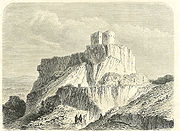
Lampron
Encyclopedia
Lampron - is a castle
near the town of Çamlıyayla
in Mersin Province
, Turkey
. While part of the Armenian Kingdom of Cilicia
in the Middle Ages
, the castle was known as Lampron and was the ancestral home of the Armenia
n Hethumid
princes. Situated in the Taurus Mountains
, the fortress guarded passes to Tarsus
and the Cilician Gates
.
. It covers an area approximately 330 by 150 meters on the top of a hill. There is a drop of more than 50 meters from the side of the hill to the river valley below.
The castle is divided in a lower and an upper ward
. The upper ward is accessible only via rock-cut stairs, and through a narrow turning entrance passage. Many of the buildings in the inner ward have collapsed into rubble, but a barrel-vaulted hall is still standing. Some of the buildings were heated by means of a hypocaust
.

Castle
A castle is a type of fortified structure built in Europe and the Middle East during the Middle Ages by European nobility. Scholars debate the scope of the word castle, but usually consider it to be the private fortified residence of a lord or noble...
near the town of Çamlıyayla
Çamliyayla
Çamlıyayla is a town and district of Mersin Province in the Mediterranean region of Turkey. The district has a population of 10.558 out of which 3335 lives in the town of Çamlıyayla.Çamlıyayla is a small district high in the Taurus Mountains...
in Mersin Province
Mersin Province
The Mersin Province is a province in southern Turkey, on the Mediterranean coast between Antalya and Adana. The provincial capital is the city of Mersin and the other major town is Tarsus, birthplace of St Paul...
, Turkey
Turkey
Turkey , known officially as the Republic of Turkey , is a Eurasian country located in Western Asia and in East Thrace in Southeastern Europe...
. While part of the Armenian Kingdom of Cilicia
Armenian Kingdom of Cilicia
The Armenian Kingdom of Cilicia , also known as the Cilician Armenia, Kingdom of Cilician Armenia or New Armenia, was an independent principality formed during the High Middle Ages by Armenian refugees fleeing the Seljuk invasion of Armenia...
in the Middle Ages
Middle Ages
The Middle Ages is a periodization of European history from the 5th century to the 15th century. The Middle Ages follows the fall of the Western Roman Empire in 476 and precedes the Early Modern Era. It is the middle period of a three-period division of Western history: Classic, Medieval and Modern...
, the castle was known as Lampron and was the ancestral home of the Armenia
Armenia
Armenia , officially the Republic of Armenia , is a landlocked mountainous country in the Caucasus region of Eurasia...
n Hethumid
Hethumids
The Hethumids , also known as the House of Lampron , were the rulers of the Armenian Kingdom of Cilicia from 1226 to 1373...
princes. Situated in the Taurus Mountains
Taurus Mountains
Taurus Mountains are a mountain complex in southern Turkey, dividing the Mediterranean coastal region of southern Turkey from the central Anatolian Plateau. The system extends along a curve from Lake Eğirdir in the west to the upper reaches of the Euphrates and Tigris rivers in the east...
, the fortress guarded passes to Tarsus
Tarsus (city)
Tarsus is a historic city in south-central Turkey, 20 km inland from the Mediterranean Sea. It is part of the Adana-Mersin Metropolitan Area, the fourth-largest metropolitan area in Turkey with a population of 2.75 million...
and the Cilician Gates
Cilician Gates
The Cilician Gates or Gülek Pass is a pass through the Taurus Mountains connecting the low plains of Cilicia to the Anatolian Plateau, by way of the narrow gorge of the Gökoluk River. Its highest elevation is about 1000m....
.
Architecture
Like many castles in the mountainous landscape of the former Kingdom of Armenia, Lampron is a spur castleSpur castle
A spur castle is a type of medieval fortification that uses its location as a defensive feature. The name refers to the location on a spur projecting from a hill...
. It covers an area approximately 330 by 150 meters on the top of a hill. There is a drop of more than 50 meters from the side of the hill to the river valley below.
The castle is divided in a lower and an upper ward
Ward (fortification)
In fortifications, a bailey or ward refers to a courtyard enclosed by a curtain wall. In particular, an early type of European castle was known as a Motte-and-bailey. Castles can have more than one ward. Their layout depends both on the local topography and the level of fortification technology...
. The upper ward is accessible only via rock-cut stairs, and through a narrow turning entrance passage. Many of the buildings in the inner ward have collapsed into rubble, but a barrel-vaulted hall is still standing. Some of the buildings were heated by means of a hypocaust
Hypocaust
A hypocaust was an ancient Roman system of underfloor heating, used to heat houses with hot air. The word derives from the Ancient Greek hypo meaning "under" and caust-, meaning "burnt"...
.


